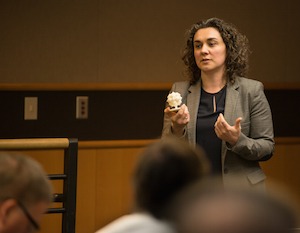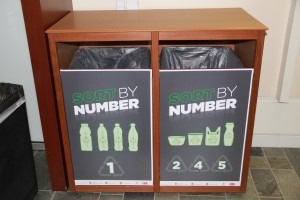How the WSB Contributed to a Unique Cross-Campus Study on Collecting Recycled Materials for 3D Printing
When Natalie Rudolph, assistant professor of mechanical engineering, kicked off a 2014-2015 study to collect multiple types of recyclable plastics for use in 3-D printing, she enlisted the help of organizations across campus, including the Wisconsin School of Business.
Rudolph’s research team wanted to develop 3-D printing material produced from 100 percent recycled waste. To determine whether or not this was feasible, her team orchestrated a unique collaboration between the WSB, the School of Human Ecology, WeConserve, and the College of Engineering, using funds from a Sustainability Innovation in Research and Education (SIRE) grant from the Office of Sustainability.

“Recycling includes the whole chain—the consumer, the transportation companies, the sorting facilities, and the recycler itself,” says Rudolph. “We can’t separate our use of resources (water, detergent, gas for trucks) for the recycling process from our technological analysis of the properties of recycled plastics. This study is a first step that includes the consumer and looks at the technical performance of the plastics. Conducting the consumer study required participation of individual units across campus. All of us were connected by our passion to help the environment.”
The first phase of the study had one objective: to test whether or not consumers could be bothered to sort plastics based on number.
Grainger Hall became the first on-campus test site, and the WSB’s Facilities and Event Services team, led by former facilities strategist Elyse Kowalczuk, worked with Rudolph to correctly implement the first phase of the study in Grainger Hall.
“Under the terms of the grant, we evaluated two things: consumers’ ability to separate and whether the separated materials were high enough quality to be used in 3-D printing,” explains Lindsey Honeyager, director of Facilities and Event Services, who notes that her staff worked with Rudolph to analyze how much, and what types of materials, students in Grainger Hall threw away, compared to how much they recycled.
“We thought about using multiple trash cans for people to sort and separate, but decided that the question we really needed to answer was ‘will people actually sort?’” says Rudolph. “That helped determine our strategy.”

The team decided to have two separate bins: one to sort out plastic bottles—plastic label number one—and one for the rest of the plastics—numbers two, four, and five.
“Unfortunately, that’s what didn’t work so well,” says Rudolph. “People could see the sign on the bin for bottles and knew where bottles needed to go, but used the other bin like a trash can, so we got a lot of food and beverage waste in there.”
Honeyager added, “Only five percent of materials sold in the Capital Café were numbers two, four, and five—the numbers needed for 3-D printing.”
The Wisconsin School of Business’s Integrated Marketing Communications (IMC) team created a campaign to educate students, faculty, and staff in Grainger Hall about sorting their trash and designed the recycling bins and signs.
“It was great to work with the marketing team at the Wisconsin School of Business to have a really nicely designed campaign,” says Rudolph. “I have a graduate student working on the project through a grant from the Office of Sustainability, and the marketing department hours were an in-kind contribution from the Wisconsin School of Business.”
WeConserve, a campus facilities group dedicated to recycling and improving the recycling stream, printed the signs and recruited student volunteers to pick up and sort the trash. Equipment at Mechanical Engineering was used to reprocess it.
“We all care so much about the environment, and it’s hard to get funding for those types of projects, so this was a productive collaboration,” said Rudolph.
Rudolph says her research team plans to take the lessons learned from the collection project and improve upon them.
“In hindsight, it may have been easier for our customers to sort if we’d had one bin for each item,” she says. “This was a baseline evaluation, putting more data toward what the WSB team had already done with her group in sorting through the trash.”

The contamination of plastics in the recycling stream is Rudolph’s next challenge.
“That would be the most interesting project on a campus level, because we have to understand what contamination we get and how we can clean it,” she says. “Even if we automate it, it takes water and detergent, so we’re still doing more homework on the energy and environmental footprint. We may ask the Wisconsin School of Business to help us with economic analytics.”
Even though they began with a study that tested how well people sort plastics, Rudolph’s team’s ultimate goal is actually to find a way to eliminate the sorting process and mix different packaging plastics together.
“What properties would this novel blend have, and what could we use it for?” asks Rudolph. “Getting rid of the sorting process is our objective in our future plastics research. We hope someday to develop the technology to allow individuals in the U.S. other parts of the world to use waste for printing.”
Tags: